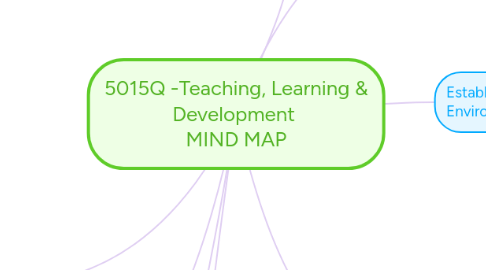
1. Making test better for students and creating GOALS!
1.1. Must assess curricular goals
1.2. Must be teachable
1.3. Assess knowledge and demonstrate effective learning
1.4. Have specific guidelines
1.5. Ask yourself if they impact the enviornment
2. Aboriginal Education
2.1. Aboriginal education is an important part of teaching students of the rich history of Canada.
2.2. Aboriginal students engagement in schools is lacking and changes need to occur to be more inclusive
3. Multicultural education
4. Stereotyping
4.1. It is importnt to recognize the differences that people share and take a multicultural approach to learning. By educating students on our differences it can make stereoypes controll less power
5. Types of Intelligence
5.1. Linguistic
5.1.1. I will insert journal entries or stories into may lesson plans to help these learners
5.2. Logical-Math
5.2.1. I can use mathemticals and calulation in lessons for example: When dealing with legal cases, understnading the times and dates of eents and how they build evidence could be a good idea
5.3. Spatial
5.3.1. Create artwork in the class to reflect the lesson. For legal cases maybe drawing the events leading up to the crime to visually explain it
5.4. Musical
5.4.1. Creating songs or jingles to help remember key terms or events
5.5. Kinesthetic
5.5.1. Getting the students up and moving around to make groups. Another example could be acting out scenarios in a law crime scene
5.6. Interpersonal
5.6.1. Classrooms debates would be a great activity in class for this group as it gets them to interact and understand the opinions of others
5.7. Intrapersonal
5.7.1. Reflections on lessons would be a good idea for this kind of learning. Getting them toshare their thoughts and opinons on specific topics talked about
5.8. Naturalistic
5.8.1. Moving the classroom outside to learn about the topic. Getting the students to look at their surrounding and explain what they see and how nature is vital to society
6. Types of assessment
6.1. Selected responses
6.1.1. Good for limiting answers and marking Also makes answers less subjective Unfortunately limits the ability to critically think about the issues or express opinions on the topic
6.2. Constructed responses
6.2.1. Allows for student to demonstrate a more thurough comprehension and understanding of the topic. Harder to mark as there is more subjectivity to answers
7. Formative
7.1. Examining how students are progressing throughout my lessons. I will sue this form of assessment to better understand what I need to modify or reteach in my lessons
8. Types of Assessment
9. a. Psychological Education
9.1. Learning and Cognition As a teacher it is important to examine the learning barriers of students. Y identifying them in classes I have I canbetter tailor lessons to their needs
9.2. Development As a teacher it is important to understand the age of students and their development when creating lesson plans. It is important that students are not given work that is too difficult for their age group.
9.3. Motivation By using a variety of tasks, students can become more engaged in your lessons. By doing the same thing over and over again this will hinder engagement.
10. Planning for the upcoming School Year
11. Assessing Student Progress
12. Individual Differences-Intellectual Abilities and Challenges
13. Socio-Cultural Considerations
14. Standardized Achievement Tests
15. Summative
15.1. Examining how students comprended the lessons over the course of the unit. These are where the grades will come from when doing report cards. They should encompass a range of different areas withi the unit and be tailored to my specific classroom
16. Diagnostic
16.1. This typ of assessment will give me a good understanding of how much my class understands before the lessons have started. This could be through simply asking some questions about lessons to come and seeing how much they know already
17. Backwards Design - This is an important tool when creating lesson plans. Creating lear goals at the beggining of the year hat need to be accomplished and using lesson plans as a way to complete these goals
17.1. Questions to ask myself when creating lesson plans
17.1.1. What do I want my students to learn?
17.1.2. How will I determine whether or not they have learned?
17.1.3. What will I teach?
17.1.4. How will I teach?
18. Students will have set expectations in my classroom and I will thefore discipline according to our set out rules we have all created together
19. Give them a sense of owership by giving them choice over certain aspects of the classroom activities
20. Establish self discipline in my classroom and self regualtion of the students
21. Make sure students look at the welfare of others and consider the impacttheir actions can have.
22. Dynamic Classroom Management
22.1. Givinging students positive behavioural support
22.2. Focus on Exploratory teacher student conversations.
22.3. Engaging all students in self regulated learning that allows them to reflect on the choices they make
23. Piaget's Four Stages of Cognitive Development
23.1. FOCUS IN CLASSROOM
23.1.1. Sensorimotor - Begin to introduce symbols
23.1.2. Pre-Operational - Foster problem solving skills and ability
23.1.3. Concrete Operations - Concentrate on arranging items and multidimensional classification
23.1.4. Formal Operations - Hypothetical situations and devising logic and abstract reasoning problems
24. Considering child and adolescent development
25. Physical and biological development Understanding the stage of biological development a student is in can be an important aspect of creating lessons. Some students may be mature enough
26. Considering Developmental Differences
27. Establishing a Positive Learning Environment
27.1. Strategies to nurture student needs
28. Making Instructional Decision
28.1. Stiggins Achievement Targets
28.1.1. Knowledge - Students understanding of facts and concepts
28.1.2. Reasoning Skills - Examining students ability to understand analytical problems
28.1.3. Products - Students ability to reflect on current skills
28.1.4. Attitudes and Dispositions - Examing students interest more about topics
